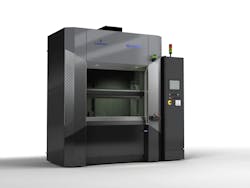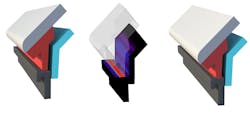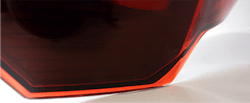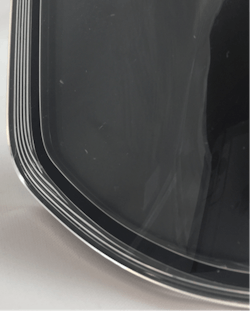Technology Comparison: Laser Welding vs. Hot-plate Welding in Automotive Lighting
Laser welding and hot-plate welding are techniques that are widely used in joining plastic parts that go into the lighting assemblies on automobiles. Hot-plate welding has been used for decades, is well understood and still relatively widely accepted. However, as lighting designs have become more sophisticated, with even greater complexity and the frequent use of built-in electronics, manufacturers today are often turning to another welding method: Simultaneous Through-Transmission Infrared, or STTIr.
The technologies are quite different. In hot-plate welding, two parts to be joined are pressed against a heated metal plate until the edges soften. The hot plate is then withdrawn, and the parts are brought together under pressure, allowing the two sections to bond as the plastic cools. The process is relatively simple—store sufficient energy into parts to melt lens and housing and then clamp to create the joint.
However, this has inherent drawbacks when it comes to precision and final visual aesthetics. The weld depth is typically 1.5 mm and more and therefore causes a relatively large lateral displacement of material known as welding flash. Also, the welding flash might be affected by the heat and fuming from heating platens, and oftentimes stringing could be present during the weld area as the part retracts from heating platen.
With STTIr laser welding, on the other hand, two components are held together under pressure in the final assembled position, as laser light passes through one part (the transmissive surface) and strikes the other (absorptive surface), where the laser energy is converted to heat that melts the interface of both parts and creates the weld with minimum flash and high aesthetics. This modern technology offers numerous advantages in today’s automotive lighting applications.
Precision and Control
Laser welding is a welding method where energy is precisely applied to a highly localized area of the joint so that heat does not affect surrounding parts, such as internal components. The designer can place even heat-sensitive parts much closer to the weld line than is possible with hot-plate welding. Precise control of welding depth is possible and, once the desired preset depth is achieved (typically tenths of a millimeter), laser energy can be deactivated.
In hot-plate welding, sufficient heat must be added to the welding line before joining to allow for the heating plate to be removed and for the parts to be pressed together. In general, a larger melt-down is needed to achieve tight welds, with resulting weld depths in hot-plate welding typically around 1.5 mm or even larger depending on lamp geometry. With laser welding, it is much easier to control heat intensity in specific sections than is possible with heated tools. For extremely tight tolerance requirements, laser welding can first heat only critical sections of the weld line perimeter before completing the rest of the weld.
Speed, Efficiency, Power Consumption
The typical cycle time for laser welding of automotive lamps is 20 to 25 sec., while a hot-plate welding cycle can be anywhere from 40 sec. to 1 min., depending on the shape of the lamp. Since it takes roughly twice as much cycle time to produce the same quantity of parts on a hot-plate machine compared to a laser welder, a hot-plate operation would require twice as much equipment, and more floor space and energy consumption, to produce the same annual volume as laser welding.
Power requirements for STTIr welding are lower compared to those of hot-plate welding because the welding sequence is so simple: Parts are loaded and pre-positioned in the lower tool. Then the welding machine strokes to clamp the parts, and the laser is activated. Heating is practically instantaneous, so energy needs to be used only during the actual weld cycle. In hot-plate applications, the heated tool must be maintained at a high temperature even during idle time, and, during the part-heating stage, a significantly larger amount of energy must be stored in the parts, so the plastics are soft enough to bond together.
More melt must be generated in the heating stage to achieve a tight joint after welding, and with weld depths around 1.5 mm (as referenced above), there is potential for flash. There are potential raw-material savings as well, since the cross-section of a typical laser-welded joint can be much thinner than one designed for hot-plate welding without compromising structural integrity.
The mechanics of a laser welder are simpler as well. There are only two platens and only one axis of movement, while in hot-plate welding there is the lift table, mirror platen and upper console, all of which have to be moved in three axes. Each of these components can have significant weight and additional power consumption is needed to move them.
Versatility
Laser welding can be used for a wide variety of materials, including all those typically used in automotive lighting. The only special requirement is that one material be laser-transparent and the other laser-absorbing, but this is a very typical configuration in automotive lighting designs—transparent lens and absorptive housing. In hot-plate welding, some materials can stick to the heated tool, causing cosmetic issues when plastic parts are separated from the heated tool.
READ MORE: 10 Tips for Automation Success
Any shape can be laser welded if the part design follows the rules for laser weldability, and the Branson application team can support application development to make essentially any shape laser weldable. High walls (which might be prone to bending in hot-plate welders) or undercuts are readily accommodated in laser welding, so designers have more freedom and flexibility to develop new shapes and features.
Automation and Integration
Laser welding systems can be easily integrated into automated production lines, offering high throughput and consistency in weld quality. While hot-plate welding can also be automated, the process may be more challenging to integrate into certain production environments due to the need for bulky equipment and longer cycle times.
Overall, laser plastic welding offers advantages in terms of precision, speed, versatility and automation compared to hot-plate welding, making STTIr a preferred choice for many applications, especially those requiring high-quality, high-throughput production. However, the choice between the two methods ultimately must be made based on specific application requirements and cost considerations.
READ MORE: Off-Road Excellence: A Case Study of Precision Machining and Craftsmanship
While cost may be a major factor in choosing one technology over another, the initial price tag should not be the only driver; energy consumption, shop floor space, versatility and other factors discussed above should also be considered. Laser welding with its flexibility offers wider range of product designs to be welded at higher throughput and helping to achieve sustainability goals reducing the power consumption.
Emma Wood is the global product manager for the Branson Non-Ultrasonic Product portfolio, which includes Laser, Vibration, Clean Vibration Technology, PulseStaking and Infrared technologies. Wood holds an undergraduate degree from Maynooth University and an MBA and an advanced program certificate in Transformational Change for Global Markets from Dublin City University.
Marian Blasko is key account manager, automotive, Branson Welding and Assembly at Emerson. Blasko joined Emerson as an application engineer and, during his career, he has worked on hundreds of projects involving a variety of plastics joining methods and has focused for several years on the automotive lightning segment. Blasko holds a PhD in mechanical engineering technologies and materials from Slovak University of Technology.
About the Author
Emma Wood
Global Product Manager, Branson Non-Ultrasonic Product Portfolio
Emma Wood is the global product manager for the Branson Non-Ultrasonic Product portfolio, which includes Laser, Vibration, Clean Vibration Technology, PulseStaking and Infrared technologies. Wood holds an undergraduate degree from Maynooth University and an MBA and an advanced program certificate in Transformational Change for Global Markets from Dublin City University.
Marian Blasko
Key Account Manager, Automotive, Branson Welding and Assembly, Emerson
Marian Blasko is key account manager, automotive, Branson Welding and Assembly at Emerson. Blasko joined Emerson as an application engineer and, during his career, he has worked on hundreds of projects involving a variety of plastics joining methods and has focused for several years on the automotive lightning segment. Blasko holds a PhD in mechanical engineering technologies and materials from Slovak University of Technology.






